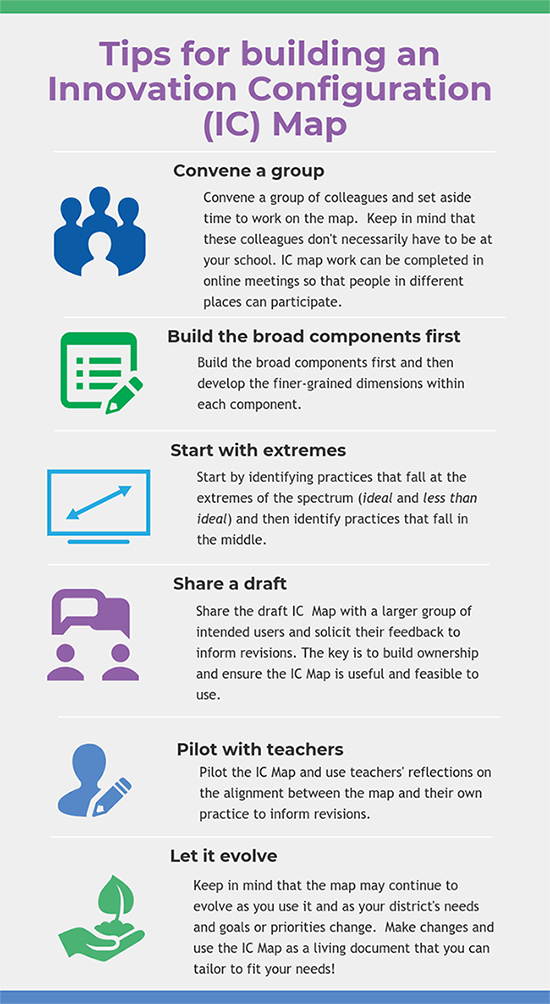Innovation Configuration Maps: A Valuable Journey and Destination
August 10, 2018
SRI International
Hannah Kistler, REL Appalachia
Magnolia Consulting
Stephanie Baird Wilkerson, REL Appalachia
The saying goes, “Life is a journey, not a destination.” REL AP staff and middle school math teachers in Jackson County, Kentucky learned that building an Innovation Configuration (IC) Map is about the journey and the destination. The new Jackson County IC Map is a valuable tool for measuring teacher practice, and the teachers who created it benefited from the collaborative development process.1
What is an IC Map and why is it useful?
An IC Map specifies behaviors and expectations related to implementing a curriculum, intervention, or evidence-based practice and categorizes these behaviors on a spectrum from ideal to less than ideal. An IC Map can be a tool for teacher reflection and self-assessment and can guide facilitators when observing and providing feedback to teachers.1 Two four-minute videos posted on the Institute of Education Sciences (IES) YouTube channel provide more information on IC maps:
Adapting an IC Map to Jackson County
The power of IC Maps lies in their relevance to teachers' contexts. REL AP staff worked with teachers in Jackson County to create a map to reflect the specific needs of teachers and the local community.
Adapting an IC Map to local teacher practices
The team members initially intended for the IC Map to measure implementation of a single mathematics curriculum. During the collaborative process, however, the team soon realized that this curriculum was not the only resource Jackson County teachers used and that the ideal practice required using multiple types of materials to best meet students' needs. Accordingly, the team broadened the scope of the map to mathematics teaching practice in Jackson County.
Through discussion the team identified five critical components of teacher practice that apply regardless of the mathematics curriculum and other resources teachers use:
- Homework
- Assessment
- Materials
- Instructional practice
- Classroom environment
Adapting an IC Map to local teacher practices

Jackson County middle school
Jackson County schools are in a rural area of Eastern Kentucky where most residents live below the poverty line. The team was mindful of the particular needs of the community, tailoring the IC Map in the following ways:
- Teachers shared that a large proportion of their students do not have Internet access at home. Accordingly, the ideal practices do not require students to have Internet access, and the IC Map specifies alternative resources students can use for homework assistance. For example, students can build mathematics notebooks in class to use as a reference when doing homework.
- Teachers shared that many parents cannot help their students with homework, especially as the math content becomes more complex. Again, the ideal practice specifies that students use mathematics notebooks as a resource, rather than relying solely on parental help at home to complete assignments.
- Teachers shared that many students enter their class lacking necessary mathematical knowledge and identified a number of important strategies for differentiation and remediation. The IC Map defines these strategies as ideal.
IC Map construction as professional development
Teachers saw the IC Map development process as a valuable form of professional development because it offered opportunities for them to collaborate, learn more about research-based practices, and reflect on their own practices.
Building the IC Map involved multiple steps:
- Initial conversations between REL AP staff and Jackson County teachers to identify the components of effective teaching.
- A four-month period of collaboration to develop the IC Map including multiple rounds of revision and iteration.
- A piloting process where REL AP staff visited classes and then asked teachers to reflect on their practice using the map. Teachers and REL AP staff made additional revisions to the map following these reflections.

Teachers and REL AP staff revised the IC map after piloting.
Teachers found that the process of developing an IC Map helped them to identify ways to improve their practice, even before they completed the map. For example, the REL AP team provided information on research-based practices to incorporate into the IC Map. Teachers reported that this information helped to push their thinking about what was “ideal.” One teacher committed to giving targeted feedback on homework more frequently after seeing the literature on the value of timely feedback.
Teachers also reported that the piloting and debriefing process was a useful form of professional development. REL AP staff observed teachers' lessons and then together, the teacher and staff member rated the teacher's practice (from ideal to less than ideal) on the IC Map, giving the teacher an opportunity to reflect on areas of strength and areas for growth. For example, after categorizing her questioning in the less than ideal category, one teacher committed to adding more higher-order thinking questions into her lesson the following day.
How can I create an IC Map?
The development and use of an IC Map can be beneficial for educators in any content area or region. If you are interested in building an IC Map, see this Jackson County map as an example and review the tips below.

Footnotes:
1Hall, G. E., & Hord, S. M. (2015). Implementing change: Patterns, principles and potholes (4th ed.). Upper Saddle River, NJ: Pearson.